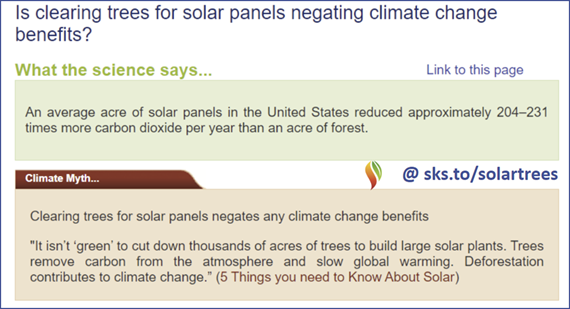
On November 1, 2024 we announced the publication of 33 rebuttals based on the report "Rebutting 33 False Claims About Solar, Wind, and Electric Vehicles" written by Matthew Eisenson, Jacob Elkin, Andy Fitch, Matthew Ard, Kaya Sittinger & Samuel Lavine and published by the Sabin Center for Climate Change Law at Columbia Law School in 2024. Below is the blog post version of rebuttal #4 based on Sabin's report.
Forests have immense ecological benefits, recreational benefits, and intrinsic value. However, when looking at the narrow but important issue of carbon accounting, it is usually not true that removing trees to build a solar farm negates any emissions reductions from solar generation. In fact, an acre of solar panels in the United States usually offsets significantly more carbon dioxide emissions than an acre of planted trees can sequester.
In the United States, the emissions intensity of electricity produced by natural gas-fired power plants is roughly 1,071 pounds of carbon dioxide per megawatt-hour (MWh).1 The emissions intensity of solar PV, meanwhile, is about 95 pounds per MWh, a difference of 976 pounds per MWh compared to natural gas. According to a 2022 Journal of Photovoltaics study, utility-scale solar power produces between 394 and 447 MWh per acre per year (Bolinger & Bolinger 2022). When displacing electricity from natural gas, an acre of solar panels, producing zero-emissions electricity would therefore save between 385,000 to 436,000 pounds, or 175 to 198 metric tons, of carbon dioxide per year.
By comparison, according to the EPA, an average acre of U.S. forest sequesters 0.857 metric tons of carbon dioxide per year.2 Thus, an average acre of solar panels in the United States reduced approximately 204–231 times more carbon dioxide per year than an acre of forest.
Furthermore, while removing trees from forests releases stored carbon, such emissions can be offset by solar energy generation and the resulting reduction in fossil fuel-driven emissions. The EPA has estimated the average acre of forests contains 83 metric tons of carbon, and approximately half of that amount is sequestered in soil.3 Even assuming that all 83 metric tons of carbon (comprising 304 metric tons of carbon dioxide)4 were released when building a solar farm on an acre of forested land, those emissions could be offset within two years of operation of a typical solar farm.5 Finally, to put the threat to forests in context, only about 4% of solar projects in the United States are being sited on currently-forested lands (Kruitwagen et al. 2021).6
[1] Nat’l Renewable Energy Laboratory, Life Cycle Greenhouse Gas Emissions from Electricity Generation: Update (Sept. 2021) (Table 1). NREL calculates emissions intensity using grams of carbon dioxide equivalent per kilowatt-hour.
[2] Greenhouse Gas Equivalencies Calculator – Revision History, U.S. Env’t Prot. Agency (last visited March 26, 2024).
[3] Greenhouse Gas Equivalencies Calculator – Calculations and References, U.S. Env’t Prot. Agency (last visited March 26, 2024).
[4] EPA’s Greenhouse Gases Equivalencies Calculator explains that, to convert carbon density to carbon dioxide density, metric tons of carbon should be multiplied by the ratio of the molecular weight of carbon dioxide to that of carbon (44/12)
[5] This calculation is based on the fact that an acre of solar panels displacing electricity from natural gas would save between 175 to 198 metric tons of carbon dioxide per year, as described earlier in this entry.
[6] Supplemental data for Supplemental Figure 10 establishes that, as of December 2018, solar capacity across all land types in the U.S. was 54.14 GW, while solar capacity across land labelled as “tree covered” was 2.15 GW. This represents roughly 4% of the total capacity.
Skeptical Science sincerely appreciates Sabin Center's generosity in collaborating with us to make this information available as widely as possible.![]()
Posted by BaerbelW on Tuesday, 26 November, 2024
 |
The Skeptical Science website by Skeptical Science is licensed under a Creative Commons Attribution 3.0 Unported License. |